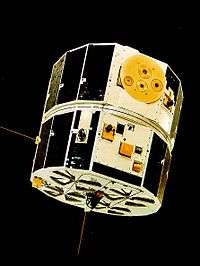Explorer 51
Explorer 51, also called as AE-C (Atmospheric Explorer C), was a NASA scientific satellite belonging to series Atmosphere Explorer, being launched on December 16, 1973 from Vandenberg AFB board a Delta 1900 rocket.
 Explorer 51 (AE-C). | |
| Mission type | Earth science |
|---|---|
| Operator | NASA |
| COSPAR ID | 1973-101A[1] |
| SATCAT no. | 6977[2] |
| Spacecraft properties | |
| Launch mass | 658 kg (1,451 lb) |
| Start of mission | |
| Launch date | 16 December 1973, 06:18 UTC[3] |
| Rocket | Delta 1900 585/D99 |
| Launch site | Vandenberg SLC-2W |
| End of mission | |
| Decay date | 12 December 1978[4] |
| Orbital parameters | |
| Reference system | Geocentric |
| Regime | Medium Earth |
| Eccentricity | 0.24086[1] |
| Perigee altitude | 149 km (93 mi)[1] |
| Apogee altitude | 4,294 km (2,668 mi)[1] |
| Inclination | 68.1°[1] |
| Period | 132.3 minutes[1] |
| Epoch | 16 December 1973[1] |
Explorers Program | |
Objectives and results
The purpose of the Explorer 51 mission was to investigate the thermosphere, with emphasis on the energy transfer and processes that govern its state. The study of photochemical processes accompanying the absorption of solar UV radiation in the earth's atmosphere was accomplished by making closely coordinated measurements of reacting constituents and the solar input.[1]
The data from Explorer 51 served, among other things, to obtain the angular load distribution around the satellite and compare it with the data of Explorer 31 and model the hydroxyl ion emissions in the Earth's atmosphere.[5]
Instruments
The satellite carried instruments to measure ultraviolet solar radiation, temperature, composition and density of the positive ions, of the neutral particles and of the electrons, to measure atmospheric glow emissions, the energy spectra of the photoelectrons and the protons and electrons flows with energies up to 25 keV.[6]
References
- "AE-C". NSSDC Master Catalog. NASA Goddard Space Flight Center.

- n2yo.com. "EXPLORER 51 (AE-C)". Retrieved June 20, 2018.
- "Jonathan's Space Page". Jonathan McDowell. Retrieved 2018-06-20.
- "Letter dated 16 May 1974 from the Permanent Representative of the United States of America addressed to the Secretary-General" (PDF). COMMITTEE ON THE PEACEFUL USES OF OUTER SPACE (74-13517): 3. UNOOSA. May 23, 1974. Retrieved 2018-06-20.
- ""The near-wake structure of the Atmosphere Explorer C /AE-C/ satellite - A parametric investigation". Journal of Geophysical Research 84: 513–525. Samir, U.; Gordon, R.; Brace, L.; Theis, R. February 1, 1979. Bibcode:1983GeoRL..10..896L.
- Langhoff, S. R.; Jaffe, R. L.; Yee, J. H.; Dalgarno, A. (September 1983). "The surface glow of the Atmosphere Explorer C and E satellites". Geophysical Research Letters 10: 896–899. Langhoff, S. R.; Jaffe, R. L.; Yee, J. H.; Dalgarno, A. 10 (9): 896. Bibcode:1983GeoRL..10..896L. doi:10.1029/GL010i009p00896.
.png)